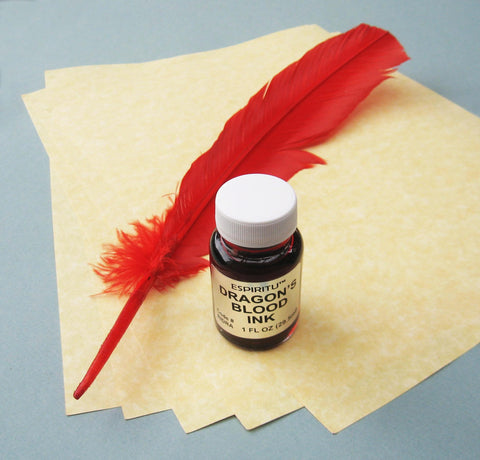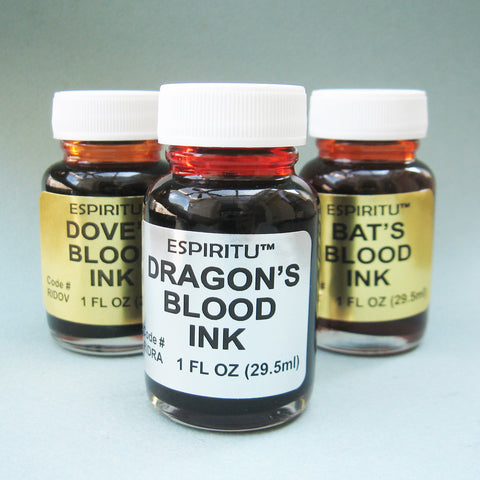
Dragon’s Blood ink is one of those magickal ingredients whose name sounds straight out of a fantasy novel. Needless to say, it doesn’t contain the blood of real dragons. Rather, the name refers to a red-tinted ceremonial ink formulated with resins, herbs, and fragrances. Dragon’s Blood ink—along with its cousins, Dove’s Blood ink and Bat’s Blood ink—is traditionally used to empower written spells, pacts, and petitions.
Dragon’s Blood ink owes its name to a bright red-colored resin that is obtained from various plant species. In ancient times, the crushed resin was used as a pigment in both the West and the East. (It was also prescribed medicinally, especially for bleeding disorders.) In the medieval era, Dragon’s Blood found its way into the disciplines of ritual magick and alchemy.
So-called “blood” inks sold today do not contain animal blood. But their names are a throwback to one of the oldest magickal tropes—the spilling of human or animal blood to empower magick spells. As these rituals would have been practiced in secret, we don’t know a lot about the history of blood magick. The pact signed in blood is a common element of the Faust legends, which can be traced back to the 6th century. Medieval grimoires contain numerous references to animal ingredients, suggesting that animal sacrifice was a reasonably common component of magick at that time.
Nowadays, of course, blood magick carries a certain stigma, and most Witches don’t feel that it’s ethical to involve poor defenseless critters in their magick spells. (Anyway, real blood doesn’t make a great writing material. It coagulates quickly, turns brown, and fades when exposed to light.) Fortunately, there are lot of options to choose from when selecting ink for writing rituals.
Making Your Own

Commercially prepared Dragon’s Blood inks are available, and most of them are perfectly suitable for ritual use. However, some people prefer to mix their own magickal inks. An online search will reveal many recipes for the stuff. A typical formula includes powdered Dragon’s Blood resin, gum arabic (to thicken the ink), and a water and/or alcohol base. Some also include herbal extracts or scents to correspond with the purpose of the ink. Keep in mind that homemade Dragon’s Blood ink will not have as smooth a texture as commercial inks, and may clog a quill or nib pen. It may also be necessary to shake or re-mix the ink before each use, as the resin particles will settle out.
If you choose to make your own ink, buy the highest quality Dragon’s Blood resin you can find. Grind it as finely as possible (most favor a mortar and pestle over a mechanical grinder) and strain the finished ink through a fine cloth or coffee filter. As some ink ingredients are toxic when consumed, be sure to store your finished ink in a labeled container away from kids and pets.
If making inks from raw materials too involved—and let’s face it, being a busy Witch doesn’t have to mean making inferior magick—there are ways to abbreviate the process. Adding ritually charged oils and elixirs to purchased ink is one way to “mix in” your own juju without starting from scratch.
Using Dragon’s Blood Ink
Dragon’s Blood resin has the property of enhancing most any magickal working, and Dragon’s Blood ink is similarly versatile. Prepare a sheet a paper (preferably parchment) and write out your command, desire, or oath. Dragon’s Blood is a really an all-purpose tool, but is most traditionally employed for spells of protection, luck, courage, and power. The best timing for a Dragon’s Blood spell is during the waxing moon and the day/hour of Mars or Jupiter.
What about the pen? In Hoodoo and rootwork traditions, magickal ink is always applied with a feather quill. But most commercially prepared inks can be easily used with a metal nib pin, too. A carved stick or even a cotton swab will do in a pinch. And if your canvas is big enough, you can even use your finger! Magickal sigils written on the body in ink will last for a few days—a perfect way to carry your intention with you. (But check for safety first, especially with homemade inks. Baneful (i.e. toxic) herbs should not be applied to the skin by inexperienced folks, and allergy tests are always a good idea.)
Types of “Blood” Ink
In our store, Dragon’s Blood is a best-seller—and it’s definitely the best choice if you’re only going to buy one magickal ink. But if you do a lot of written magick, you may want to stock up on these varieties:
Dove’s Blood
Dove’s Blood ink is traditionally used for spells involving love, desire, blessings, reconciliation, friendship and loyalty. It’s also used to seal pacts and promises. Its magickal heritage stretches back to Ancient Greece when a pair of doves (Her favorite bird) would be sacrificed to Aphrodite by love petitioners. Dove’s Blood ink is attributed to Venus. Usually it is a dark pink or red ink with essences of Venus herbs (e.g. Rose, Jasmine, or Geranium).
Bat’s Blood
Bat’s Blood ink is a prized tool of the Witch with a lot of enemies! It’s traditionally used for spells of binding and protection, and for casting and removing curses and jinxes. It is attributed to Saturn and (in the case of aggressive magick) to Mars. It may be red, purple, or black, depending on the maker. Herbal additives may include Myrrh, Cinnamon, and other spicy or bitter botanicals.
Butterfly’s Blood
Probably the rarest of the bunch, Butterfly’s Blood ink is reserved for inscribing sacred words and talismans. Occasionally it is used in petitions to request insight or divine guidance. It is an orange/gold ink and was originally made from precious Saffron. Correspondences for Butterfly’s Blood are Mercury and the Sun.
Check out our other articles!
Photo: Trio of magickal ink by Espiritu.


